Vol. 1, No. 5
- - - - - - - - - - - - - - - - - - - - - - - - - - - - - - - - - - - - - - - - - - - - - - - - In this issue:
In this issue:
reviews of Gotham Central #33-34, Justice #1, and DC Special: The Return of Donna Troy #3 /
notes on metafiction in New Avengers #8, a Teen Titans: Classified ongoing, my foray into the mind of Morrison, Peanuts on a Budget, and more / rants about my ugly breakup with Chris Claremont
- - - - - - - - - - - - - - - - - - - - - - - - - - - - - - - - - - - - - - - - - - - - - - - -
reviews
Gotham Central #33 and #34 (DC Comics)
Ed Brubaker and Greg Rucka (Writers) / Kano (Penciller) / Stefano Gaudiano (Inker) / Lee Loughridge (Colorist) It was a cheap trick, but it worked. I can never say no to the Titans (much as I have sometimes wanted to), and this week they got me to pick up two issues of Gotham Central, a title I’ve never tried before, but am now quite taken with.
It was a cheap trick, but it worked. I can never say no to the Titans (much as I have sometimes wanted to), and this week they got me to pick up two issues of Gotham Central, a title I’ve never tried before, but am now quite taken with.
These two issues--Parts 1 and 2 of the new “Dead Robin” four-parter--have a lot to recommend them. The main story, which focuses on the Gotham P.D.’s investigation of a dead boy dressed in a Robin costume is immediately involving on two levels.  As Law and Order: SVU reminds us almost every week, violence directed at children is not only viscerally disturbing, but, it would seem, endlessly fascinating as well. In the hierarchy of crimes it is among the most reprehensible, and as such it is an inevitable subject for those genres of popular fiction that thrive on the exploration of extremes, usually in order to give us what we want after a long day at the salt mines: the satisfaction of confirming what we already know, or think we know, about the nature of good and evil and the inevitable triumph of the former over the latter. When the theme is examined in the context of a police procedural, as it is in Gotham Central, the emphasis typically falls less on the horror of the act than on the redemptive process of crime-solving--the gritty romance and bleak optimism of police work that reassures us that order and justice are not unattainable goals.
As Law and Order: SVU reminds us almost every week, violence directed at children is not only viscerally disturbing, but, it would seem, endlessly fascinating as well. In the hierarchy of crimes it is among the most reprehensible, and as such it is an inevitable subject for those genres of popular fiction that thrive on the exploration of extremes, usually in order to give us what we want after a long day at the salt mines: the satisfaction of confirming what we already know, or think we know, about the nature of good and evil and the inevitable triumph of the former over the latter. When the theme is examined in the context of a police procedural, as it is in Gotham Central, the emphasis typically falls less on the horror of the act than on the redemptive process of crime-solving--the gritty romance and bleak optimism of police work that reassures us that order and justice are not unattainable goals.
This is the framework of the series, and Brubaker and Rucka supplement a snappily-dialogued presentation of unglamorous sleuthing with an appealing cast of characters (Captain Maggie Sawyer especially, fondly remembered from Superman) and a squad room packed with juicy subplots and simmering grudges against rival Gotham detective, Batman, who is pursuing an investigation of his own into the death of the young Robin imposter.
What makes the story really compelling, however, is how the hybrid cops-and-capes premise of the series complicates the murdered child motif of pulps and prime time cop shows, turning it into an exploration of the dead sidekick riff that has long been a fixture of the Bat-books. The developments in Part 2 of the story suggest either that there is a truly perverse criminal at work here, or something even more interesting that I’ll hold off speculating about for now (my guesses are always wrong anyway). Suffice it to say, it’s a tantalizing, well-paced mystery that has the potential to be a noteworthy exploration of the wider social implications of Batman-Robin partnership. Meanwhile, as we wait for the mystery to unfold, there are plenty of treats in these first two issues. Foremost among these is the moody alt-comix art by Kano and Stefano Gaudiano, nicely colored in muted tones by Lee Loughridge. Their grainy, rain-soaked Gotham perfectly captures what the city would likely feel like from the perspective of beleaguered detectives: gloomy, seedy, menacing--and as much as they might resent it, more Batman’s city than theirs. There’s a wonderful sequence in issue #33 that has Batman emerging from the shadows of a rooftop to warn the police against interfering with his own investigation of the dead boy. Kano draws him as an extension of the architecture, always in shadows or in silhouette, emanating from the city like Gotham’s phantom self.
Meanwhile, as we wait for the mystery to unfold, there are plenty of treats in these first two issues. Foremost among these is the moody alt-comix art by Kano and Stefano Gaudiano, nicely colored in muted tones by Lee Loughridge. Their grainy, rain-soaked Gotham perfectly captures what the city would likely feel like from the perspective of beleaguered detectives: gloomy, seedy, menacing--and as much as they might resent it, more Batman’s city than theirs. There’s a wonderful sequence in issue #33 that has Batman emerging from the shadows of a rooftop to warn the police against interfering with his own investigation of the dead boy. Kano draws him as an extension of the architecture, always in shadows or in silhouette, emanating from the city like Gotham’s phantom self. 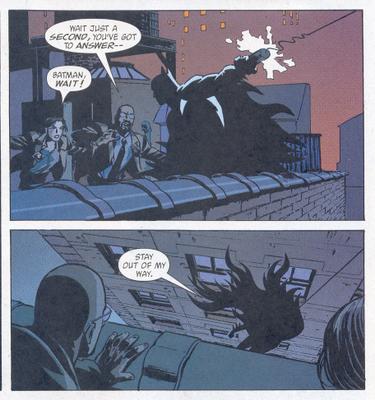 When he is stationary, Kano’s Batman is always lurking, hunched over, or crouching, ready to spring. And when he’s in motion he’s a blur, a chaos of black tendrils disappearing into the night, a squeal of tires vanishing around a sharp corner. Kano draws him as he might appear to us or to the police: an embodied myth, concrete one moment, and then, suddenly, gone. Not unlike Dave Gibbons’s memorable renderings of V.
When he is stationary, Kano’s Batman is always lurking, hunched over, or crouching, ready to spring. And when he’s in motion he’s a blur, a chaos of black tendrils disappearing into the night, a squeal of tires vanishing around a sharp corner. Kano draws him as he might appear to us or to the police: an embodied myth, concrete one moment, and then, suddenly, gone. Not unlike Dave Gibbons’s memorable renderings of V.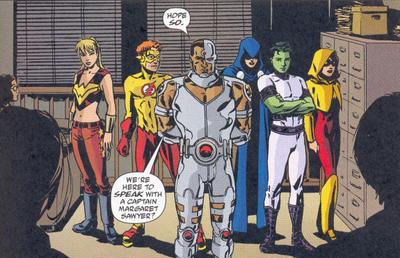 The main pleasure of issue #34 (and the reason I bought the book) is an extension of this simultaneously realistic and mythic Batman: it’s the weird pleasure of genre-merging that brings brightly clad superheroes into the noirish world of the police procedural. The set up is that Sawyer calls Robin’s Teen Titan friends in for questioning because the police can’t be sure that the dead boy isn’t the real Robin, and Brubaker and Rucka have some real fun staging the squad room encounter between the teen heroes and the salty yet bemused detectives. These are Titans for whom the laws of gravity still apply (well...except, perhaps, Starfire), and the generic mash-up is strangely pleasing to watch, even if it seems somewhat superfluous to the story.
The main pleasure of issue #34 (and the reason I bought the book) is an extension of this simultaneously realistic and mythic Batman: it’s the weird pleasure of genre-merging that brings brightly clad superheroes into the noirish world of the police procedural. The set up is that Sawyer calls Robin’s Teen Titan friends in for questioning because the police can’t be sure that the dead boy isn’t the real Robin, and Brubaker and Rucka have some real fun staging the squad room encounter between the teen heroes and the salty yet bemused detectives. These are Titans for whom the laws of gravity still apply (well...except, perhaps, Starfire), and the generic mash-up is strangely pleasing to watch, even if it seems somewhat superfluous to the story. 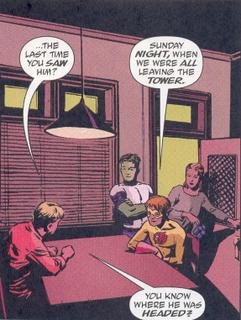 The weirdness of the mix is broadcast through the use of color (as I imagine it is throughout the series): the bright costumes of the Titans are set in contrast to the subdued palette of greens, browns, and yellows Loughridge uses to define the G.C.P.D. squad room. And yet, the coloring also mediates the generic conjunction of cop and superhero by dulling the colors of the Titans’ outfits, bringing them into line with the book’s noir aesthetic. It’s an uncanny effect that makes the potentially unbelievable conjunction into something else entirely.
The weirdness of the mix is broadcast through the use of color (as I imagine it is throughout the series): the bright costumes of the Titans are set in contrast to the subdued palette of greens, browns, and yellows Loughridge uses to define the G.C.P.D. squad room. And yet, the coloring also mediates the generic conjunction of cop and superhero by dulling the colors of the Titans’ outfits, bringing them into line with the book’s noir aesthetic. It’s an uncanny effect that makes the potentially unbelievable conjunction into something else entirely.
I’m intrigued by the main cast of detectives, but my first love is still superheroes, and these scenes with the Titans epitomize what I like about this book: the generic dissonance produced by the story’s police procedural frame defamiliarizes the superheroic DCU just enough that we begin to see characters like Batman or the Titans through the lens of a kind of heightened realism. There’s more depth to Gotham city here than we get in the average Bat-book--a depth that was also present in Warren Ellis and Butch Guice’s outstanding presentation of similarly stylized but fully developed Daily Planet in JLA: Classfied #10 last week, a depth further generated by Guice’s stunning establishing shots of Metropolis, Gotham (below), and Themyscira. (Kano and Gaudiano provide wonderful establishing shots too, on a smaller, but no less effective scale.) 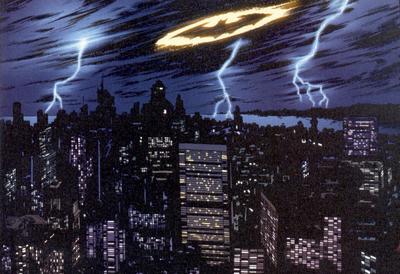 Although some readers are not impressed with the so-called “grim and gritty” road that the DCU is following right now as Johns, Rucka, and others unpack the implications of Brad Meltzer’s incendiary Identity Crisis, I’m enjoying it unremittingly, despite its glitches and occasional blunders. One of the reasons is precisely the newfound sense of realistic depth and integration that it is bringing to the DCU as a whole.
Although some readers are not impressed with the so-called “grim and gritty” road that the DCU is following right now as Johns, Rucka, and others unpack the implications of Brad Meltzer’s incendiary Identity Crisis, I’m enjoying it unremittingly, despite its glitches and occasional blunders. One of the reasons is precisely the newfound sense of realistic depth and integration that it is bringing to the DCU as a whole.  It isn’t just that there seems suddenly to be real things at stake in the interactions between the more sharply-defined characters, but that the elements of this universe, its cities and even its planets, suddenly seem more distinctive and more real as well. Hopefully, one of the side effects of this exhilarating integration and heightened realism will be an increased readership for books like Gotham Central and the now officially pined for Ellis/Guice Daily Planet series. I bought these two issues of Gotham Central because I’m a shameless Teen Titans nut, but I’m adding the series to my pull list because (a) it’s really good and (b) DC has made me care about their whole Universe again in a way that I haven’t since the mid-eighties (though the magical first few years of the Byrne-spear-headed Superman relaunch came close--and there, again, it boiled down to creating a sense of realistic depth by building up entire cities and a vast cast of supporting non-powered characters in rich, complex detail). What an energized DC means, from my myopic point of view, is that books like Gotham Central no longer look like strays languishing in some isolated genre-pocket of the DCU (a crime or Bat-Universe book), but like part of a larger whole that suddenly seems worth taking a chance on. In this case, the chance was worth it. And I hear that Gotham Central #37 will be tying in to Infinite Crisis. Interesting...
It isn’t just that there seems suddenly to be real things at stake in the interactions between the more sharply-defined characters, but that the elements of this universe, its cities and even its planets, suddenly seem more distinctive and more real as well. Hopefully, one of the side effects of this exhilarating integration and heightened realism will be an increased readership for books like Gotham Central and the now officially pined for Ellis/Guice Daily Planet series. I bought these two issues of Gotham Central because I’m a shameless Teen Titans nut, but I’m adding the series to my pull list because (a) it’s really good and (b) DC has made me care about their whole Universe again in a way that I haven’t since the mid-eighties (though the magical first few years of the Byrne-spear-headed Superman relaunch came close--and there, again, it boiled down to creating a sense of realistic depth by building up entire cities and a vast cast of supporting non-powered characters in rich, complex detail). What an energized DC means, from my myopic point of view, is that books like Gotham Central no longer look like strays languishing in some isolated genre-pocket of the DCU (a crime or Bat-Universe book), but like part of a larger whole that suddenly seems worth taking a chance on. In this case, the chance was worth it. And I hear that Gotham Central #37 will be tying in to Infinite Crisis. Interesting...
Justice #1 (DC Comics)
Jim Krueger and Alex Ross (Story) / Jim Krueger (Script) / Doug Braithwaite and Alex Ross (Art) Justice is a weird book.
Justice is a weird book.
On the one hand, it’s absolutely stunning to look at, and the premise--that the world’s super-villains are haunted by an apocalyptic dream of the Justice League’s failure to save the world and are taking matters into their own hands--is an appealing set up for an examination of the title theme.
And yet, I can’t say I really enjoyed it. Despite the fact that this is a group effort, Justice still feels like Alex Ross’s book, and as much of an asset as he undeniably is to DC, he is also, for some readers at least, a liability. The problem with Ross’s work, I think, has nothing to do with his skill, which is obviously tremendous, but with the relation of his style to the current marketplace and especially its relation to the look and feel of the revitalized DC universe.
What’s great about the new DC is that it isn’t really “new” at all. As Dan Didio’s team of world-builders continually tells us, they are not reinventing the wheel, they are merely repairing some potholes and constructing a much more complex and fascinating network of roads. By all rights, Ross’s brand of nostalgia should be a perfect fit for this project, but it doesn’t work for me for two reasons, both of which relate to the disconnect between his nostalgia and that of the DC world-builders led by Geoff Johns. First, Ross’s famous photorealistic painting style reminds us of a time when comics struggled for legitimacy on terms that were not set by the comics industry itself but were, in effect, uncritically inherited from the culture at large. Ross’s art for Kingdom Come, in other words, seemed important and groundbreaking because everyone, even my Aunt Mabel, could immediately recognize that painting was superior to comic book doodling in the eternal hierarchy of artistic achievement. I intend no disrespect to Ross’s talent when I say that anyone sensible (Ross included, I expect) knows this type of prejudice to be bullshit. My point is only that Ross had both the good and ill fortune to become the poster-boy not only for a certain type of popular breakthrough for superhero comics, but also, implicitly, for this genre’s deepest insecurities and bad conscience. The indifference to--even the backlash one senses against--Ross now is in part the consequence of his artwork’s prominent role in the mainstream legitimization of the superhero.
First, Ross’s famous photorealistic painting style reminds us of a time when comics struggled for legitimacy on terms that were not set by the comics industry itself but were, in effect, uncritically inherited from the culture at large. Ross’s art for Kingdom Come, in other words, seemed important and groundbreaking because everyone, even my Aunt Mabel, could immediately recognize that painting was superior to comic book doodling in the eternal hierarchy of artistic achievement. I intend no disrespect to Ross’s talent when I say that anyone sensible (Ross included, I expect) knows this type of prejudice to be bullshit. My point is only that Ross had both the good and ill fortune to become the poster-boy not only for a certain type of popular breakthrough for superhero comics, but also, implicitly, for this genre’s deepest insecurities and bad conscience. The indifference to--even the backlash one senses against--Ross now is in part the consequence of his artwork’s prominent role in the mainstream legitimization of the superhero.
The architects of the new DCU are experimenting with “realism” in various forms too, of course, but it is not Ross’s realism. It is not (inadvertently) apologetic and doesn’t have even a trace of the bad conscience that Ross’s art (unintentionally) evokes. (I want to be clear that I am not attributing this bad conscience to Ross himself; it is merely an "effect" of his style, rooted in the context of its reception and independent of intention.) Certain aspects of the new DCU may be “grim” and “gritty” (sometimes tastelessly so), but it is also a completely internal (even insular) celebration of comic book superhero conventions, tropes, and histories. Didio may have the bottom line and the mainstream market constantly in his sights, but the feeling DC’s line-wide overhaul evokes for me is very far from the sober plea to be taken seriously that emanates from Kingdom Come, and now, unfortunately, from Justice. The second problem, with Ross’s superheroes is, I suspect, more idiosyncratic, both on Ross’s part and on mine. I just don’t like any of these heroes. Ross (and evidently Krueger and Braithwaite too) seem determined to give us a pantheon superhero daddies. Superman, Flash, Green Lantern, and Aquaman all look and act, in this issue, like insufferable, humorless patriarchs. In this day and age, such square, hulking fathers with their gruff, teary-eyed nobility are preposterous at best, and reactionary at worst. In any event, Aquaman and Mera’s Odysseus-Penelope routine certainly isn’t my fantasy of heroism. This is why the hilarious, buzz-worthy seahorse panel comes as such a relief, as does the desert scene with “It” badguy Leonard Snart. Perhaps the heroes will lighten up a bit as the series develops, and maybe this is all setting up some ingenious reversal down the line that will set these boring patriarchs on their ears. Maybe. But on the evidence of the first issue at least, this is not the kind of nostalgia that is informing the general DC revamp where the past is typically reinvented rather than merely fetishized. I’ll give Justice a few issues to see where it’s going, but right now, its 1950s groove feels more than a little musty.
The second problem, with Ross’s superheroes is, I suspect, more idiosyncratic, both on Ross’s part and on mine. I just don’t like any of these heroes. Ross (and evidently Krueger and Braithwaite too) seem determined to give us a pantheon superhero daddies. Superman, Flash, Green Lantern, and Aquaman all look and act, in this issue, like insufferable, humorless patriarchs. In this day and age, such square, hulking fathers with their gruff, teary-eyed nobility are preposterous at best, and reactionary at worst. In any event, Aquaman and Mera’s Odysseus-Penelope routine certainly isn’t my fantasy of heroism. This is why the hilarious, buzz-worthy seahorse panel comes as such a relief, as does the desert scene with “It” badguy Leonard Snart. Perhaps the heroes will lighten up a bit as the series develops, and maybe this is all setting up some ingenious reversal down the line that will set these boring patriarchs on their ears. Maybe. But on the evidence of the first issue at least, this is not the kind of nostalgia that is informing the general DC revamp where the past is typically reinvented rather than merely fetishized. I’ll give Justice a few issues to see where it’s going, but right now, its 1950s groove feels more than a little musty.
DC Special: The Return of Donna Troy #3 (DC Comics)
Phil Jimenez (Writer) / José Luis Garcia Lopez (Pencils) / George Pérez (Inks) / Lee Loughridge (Colors)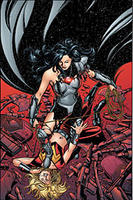 Everyone seems irritated by this series, even Phil Jimenez (kidding, Phil!), yet I continue, defiantly, to be charmed by it. And this despite the fact that I’ve never liked the Titans of Myth, not even a little bit.
Everyone seems irritated by this series, even Phil Jimenez (kidding, Phil!), yet I continue, defiantly, to be charmed by it. And this despite the fact that I’ve never liked the Titans of Myth, not even a little bit.
Many are no doubt buying this book merely for the art--and who could blame them? The issue is primarily a showcase of Donna’s strength and skill as she decimates her former teammates, and in lesser artistic hands it might feel flat, but Garcia Lopez and Pérez are as dazzling as ever and their action sequences are hyperkinetic.  The two-page spread of Donna fighting Cyborg is breathtaking--if all fight scenes were choreographed this precisely, well...I’d be a lot more interested in fight scenes. The battle-staff match between Donna and Kory recalls a similar skirmish between Starfire and Blackfire back in the good old days, and her brief tangle with Roy is a nice bit of foreplay for the tender scene between them later.
The two-page spread of Donna fighting Cyborg is breathtaking--if all fight scenes were choreographed this precisely, well...I’d be a lot more interested in fight scenes. The battle-staff match between Donna and Kory recalls a similar skirmish between Starfire and Blackfire back in the good old days, and her brief tangle with Roy is a nice bit of foreplay for the tender scene between them later.
Here, in the space of seven panels, Jimenez presents us with a compressed catalogue of Donna’s attributes that confirms Perez’s description of her as “a feminine ideal...basically the girl next door that everyone just has to fall in love with...rather perfect in her own way--strong, intelligent, giving, loving and of course, gorgeous” (Wizard #165: July 2005).  To this catalogue of male fantasy Jimenez adds: thoughtful, coy, vulnerable, though, and sensitive. The girl who could kick your ass, but seems, inexplicably, to still need rescuing. Sensitive, damaged letch, Roy Harper, is the perfect guy to appreciate her (since he needs rescuing as much as she does) and he is, in any case, an attractive proxy for male readers who would like to think of themselves as a little rougher around the edges than they actually are (present company excepted, of course...).
To this catalogue of male fantasy Jimenez adds: thoughtful, coy, vulnerable, though, and sensitive. The girl who could kick your ass, but seems, inexplicably, to still need rescuing. Sensitive, damaged letch, Roy Harper, is the perfect guy to appreciate her (since he needs rescuing as much as she does) and he is, in any case, an attractive proxy for male readers who would like to think of themselves as a little rougher around the edges than they actually are (present company excepted, of course...).  This all sounds vaguely like criticism, but who am I kidding? I love Donna too, and this book is doing a bang up job of catering to saps like yours truly. The character desperately needed reestablishing after almost a decade of harrowing retcons that may have solved certain continuity problems, but left the character an empty husk. The reason this series likely is not appealing to some readers is that despite the Infinite Crisis tie-in, the story is basically a character reconstruction, seemingly intended to restore the emotional resonance Donna’s character achieved in The New Teen Titans #38, the story from which everything since has sprung and run steadily downhill. Not even Wolfman and Perez ever surpassed the perfection of this issue (which I’ll return to in a future post), so it’s not surprising that Donna Troy has been more frustrating than satisfying in the intervening years. The fight scenes are really just dramatizations of Donna’s endless identity crises, and one suspects, represent her final coming to terms with her cumbersome and contorted history. A final settling of accounts.
This all sounds vaguely like criticism, but who am I kidding? I love Donna too, and this book is doing a bang up job of catering to saps like yours truly. The character desperately needed reestablishing after almost a decade of harrowing retcons that may have solved certain continuity problems, but left the character an empty husk. The reason this series likely is not appealing to some readers is that despite the Infinite Crisis tie-in, the story is basically a character reconstruction, seemingly intended to restore the emotional resonance Donna’s character achieved in The New Teen Titans #38, the story from which everything since has sprung and run steadily downhill. Not even Wolfman and Perez ever surpassed the perfection of this issue (which I’ll return to in a future post), so it’s not surprising that Donna Troy has been more frustrating than satisfying in the intervening years. The fight scenes are really just dramatizations of Donna’s endless identity crises, and one suspects, represent her final coming to terms with her cumbersome and contorted history. A final settling of accounts. More generally, and apart from its visual splendor, the reason I like this series is because Jimenez seems almost to inhabit that period of Titans history that made us love these characters in the first place, and he is able to bring this period into the present DCU as surely as if it was passed through the nexus-zone on Minosyss. Once this is finished, Jimenez will have written the last “Who Is Donna Troy?” story we will see in a long, long while, hopefully forever. It’s not for everyone, I grant, but for this Titan fan, it’s a sweet homecoming that promises a bright future.
More generally, and apart from its visual splendor, the reason I like this series is because Jimenez seems almost to inhabit that period of Titans history that made us love these characters in the first place, and he is able to bring this period into the present DCU as surely as if it was passed through the nexus-zone on Minosyss. Once this is finished, Jimenez will have written the last “Who Is Donna Troy?” story we will see in a long, long while, hopefully forever. It’s not for everyone, I grant, but for this Titan fan, it’s a sweet homecoming that promises a bright future.
notes
The Metafiction Police: New Avengers #8 New Avengers #8 was a mixed bag, but basically I enjoyed it. Despite my strong dislike of issue seven’s metafictional cliffhanger, the opening sequence of this issue--a 3-page comic book Sentry story written by “Perky” (?) Paul Jenkins and drawn by “Sassy” (!) Sal Buscema--is fun, and the two-page spread in which we move from the comic-within-a-comic to the main action is smoothly executed. The drastic shift in art styles and panel layouts creates a heightened sense of realism, but even neater is the way that we and the sentry are put in the same position of turning the pages of a comic book and having our sense of its reality/fictionality disrupted and reorganized. The Jenkins cameo is mercifully short, and artists McNiven and Morales infuse the Sentry's dilemma with real pathos. I stand by my original gripe, but Bendis and company basically pull off a bad idea as gracefully as one could hope.
New Avengers #8 was a mixed bag, but basically I enjoyed it. Despite my strong dislike of issue seven’s metafictional cliffhanger, the opening sequence of this issue--a 3-page comic book Sentry story written by “Perky” (?) Paul Jenkins and drawn by “Sassy” (!) Sal Buscema--is fun, and the two-page spread in which we move from the comic-within-a-comic to the main action is smoothly executed. The drastic shift in art styles and panel layouts creates a heightened sense of realism, but even neater is the way that we and the sentry are put in the same position of turning the pages of a comic book and having our sense of its reality/fictionality disrupted and reorganized. The Jenkins cameo is mercifully short, and artists McNiven and Morales infuse the Sentry's dilemma with real pathos. I stand by my original gripe, but Bendis and company basically pull off a bad idea as gracefully as one could hope.
Lost Causes Department: Teen Titans: Classified Now that my already flimsy credibility is completely shot, thanks to my ode to DC Special #3, I may as well ask the question I’ve been mulling over this week: when is DC going to announce a Jimenez-fronted Teen Titans: Classified that would allow him to tell Titans stories set in that golden age of Titans history? He would write and draw some, of course. But hopefully we’d also get new stories written by Wolfman and Johns and illustrated by new as well as classic Titans artists like Garcia Lopez, Tom Grummett, and the criminally underrated Eduardo Barretto.
Now that my already flimsy credibility is completely shot, thanks to my ode to DC Special #3, I may as well ask the question I’ve been mulling over this week: when is DC going to announce a Jimenez-fronted Teen Titans: Classified that would allow him to tell Titans stories set in that golden age of Titans history? He would write and draw some, of course. But hopefully we’d also get new stories written by Wolfman and Johns and illustrated by new as well as classic Titans artists like Garcia Lopez, Tom Grummett, and the criminally underrated Eduardo Barretto.  I’d include Perez in this list, but he needs to finish the Games graphic novel (which has apparently been temporarily shelved, again). Come to think of it, the release of Games would make a nice lead-in to the launch of the Teen Titans: Classified regular series. Come on Dan Didio, you know you want to.
I’d include Perez in this list, but he needs to finish the Games graphic novel (which has apparently been temporarily shelved, again). Come to think of it, the release of Games would make a nice lead-in to the launch of the Teen Titans: Classified regular series. Come on Dan Didio, you know you want to.
For other Titans related images and info, visit Bill Walko's incredible Titans Tower site.
Teaser of the Week: JSA #76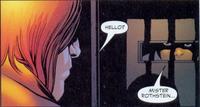 Re: Al Rothstein’s conversation with...
Re: Al Rothstein’s conversation with...
Hell, yeah!! (I’ve been waiting for this, and yet it still caught me by surprise.)
Scripting of the Week: New Avengers #8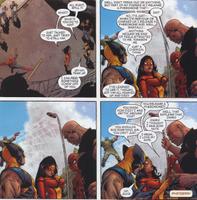 Mr. Bendis? About that metafiction snafu? All is forgiven.
Mr. Bendis? About that metafiction snafu? All is forgiven.
Seven Soldiers For Dummies
We established last week that I am an idiot for waiting for the Morrison trades. I am taking steps to rectify this situation, starting with the purchase of Klarion #2.  Can’t say I know what’s going on, exactly, but my goodness, what fun. After the dour “Limbo Town” of Justice #1, loopy witch-boy Klarion’s journey through the wonders and horrors of a Dickensian sewer system to the seat of an absent witch-god seems, paradoxically, like a breath of fresh air. Sinister, cynical guide Ebeneener Badde makes a neat foil to the madcap protagonist, Klarion, an “innocent abroad” pushed to a Morrisonian extreme of almost demented giddiness. I am enthralled with Frazer Irving’s incredible visuals, which sometimes look nearly like woodcuts. Gorgeous.
Can’t say I know what’s going on, exactly, but my goodness, what fun. After the dour “Limbo Town” of Justice #1, loopy witch-boy Klarion’s journey through the wonders and horrors of a Dickensian sewer system to the seat of an absent witch-god seems, paradoxically, like a breath of fresh air. Sinister, cynical guide Ebeneener Badde makes a neat foil to the madcap protagonist, Klarion, an “innocent abroad” pushed to a Morrisonian extreme of almost demented giddiness. I am enthralled with Frazer Irving’s incredible visuals, which sometimes look nearly like woodcuts. Gorgeous.
Peanuts on a Budget I’m saving my pennies, but it’s going to be awhile before I can afford Fantagraphics’s exquisite Complete Peanuts collections. In the meantime, I'm trying to content myself with this copy of Let’s Face It, Charlie Brown! that I got for a nickel at a garage sale this summer. Most of the strips have been disassembled for vertical display, to fit the pocketbook-sized pages, and annoying though this is, sometimes the reorganization of panels contributes something unexpected to the effect. Here is one I particularly like for its suggestion of stasis and circularity:
I’m saving my pennies, but it’s going to be awhile before I can afford Fantagraphics’s exquisite Complete Peanuts collections. In the meantime, I'm trying to content myself with this copy of Let’s Face It, Charlie Brown! that I got for a nickel at a garage sale this summer. Most of the strips have been disassembled for vertical display, to fit the pocketbook-sized pages, and annoying though this is, sometimes the reorganization of panels contributes something unexpected to the effect. Here is one I particularly like for its suggestion of stasis and circularity: A couple of Peanuts links worth clicking:
A couple of Peanuts links worth clicking:
Making a Graphic Novel
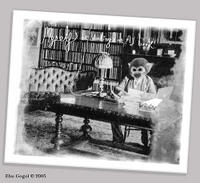 Ebu Gogol has a brand new horror/graphic novel site that is difficult to describe but worth the visit. His paranoid (justifiably anxious?) attempt to tell his story, “Eater of the Dead,” is creepily addictive. Check it out here.
Ebu Gogol has a brand new horror/graphic novel site that is difficult to describe but worth the visit. His paranoid (justifiably anxious?) attempt to tell his story, “Eater of the Dead,” is creepily addictive. Check it out here. Forthcoming at Double Articulation
Forthcoming at Double ArticulationAt the risk of embarrassing everyone, next week Double Articulation begins a rather personal three-part series on love in comics. First up, Amazing Spider-Man #205 where we learn, “At Long Last... The Shocking Secret of the Black Cat!” Consider yourself warned.

rants
Breaking Up Is Hard To Do: On Buying Comics I Don’t Enjoy
 I can remember a time when Chris Claremont’s Uncanny X-Men used to be the first title I read when I got back from the comic store, unless it was a New Teen Titans week, in which case it was second. This was back when there was only one main X-title plus the New Mutants, back when it wasn’t known as Uncanny but simply as X-Men.
I can remember a time when Chris Claremont’s Uncanny X-Men used to be the first title I read when I got back from the comic store, unless it was a New Teen Titans week, in which case it was second. This was back when there was only one main X-title plus the New Mutants, back when it wasn’t known as Uncanny but simply as X-Men. Lately it’s been the last title I read, and usually it languishes for a day or two until I’m actually bored enough to bother.
For a few brief moments almost twenty issues ago, it looked like the teaming of Claremont and Davis was really going to be fun. But the fun barely lasted for three months and now I find myself wondering why I’ve stuck with this book for more than a year. I’d like to blame Alan Davis and his beautiful drawings, but that’s only part of it. The bigger problem is that my threshold for tolerating things I dislike on the (groundless) expectation that they will immanently improve is simply far too high. It takes a lot to wear me down and though there is a tipping point, it’s usually only triggered by something so offensive that it’s actually insulting, such as Marvel’s incomprehensible rejigging of Thunderbolts into a wrestling comic for a few issues at the end of its first run.
 The truth is that I haven’t really enjoyed the X-Men since Grant Morrison left, and it seems unlikely that anyone is going to top that invigorating run anytime soon. (Not even Whedon’s Scooby-style Astonishing, which is enjoyable but inconsistently thrilling, can touch it.) I’ve always liked science historian Thomas Kuhn’s famous distinction between “paradigm shifts” and “normal science,” the former indicating a revolution in thought that establishes an new overarching set of assumptions and the latter being the minor tinkering and puzzle-solving that follows this revolutionary shift and tries to fill in the gaps that are left in the new paradigm’s wake. I’m not sure if the analogy holds perfectly, but Morrison’s relatively recent run on X-Men, like Claremont’s original run, marked a genuine paradigm shift in how the book was written and conceived. Claremont’s current run feels a lot more like the drudgery of “normal science,” a science that may be productive of some minor pleasures, insights, and discoveries, but is largely concerned with worrying and refining elements of a paradigm shift that now feels increasingly remote.
The truth is that I haven’t really enjoyed the X-Men since Grant Morrison left, and it seems unlikely that anyone is going to top that invigorating run anytime soon. (Not even Whedon’s Scooby-style Astonishing, which is enjoyable but inconsistently thrilling, can touch it.) I’ve always liked science historian Thomas Kuhn’s famous distinction between “paradigm shifts” and “normal science,” the former indicating a revolution in thought that establishes an new overarching set of assumptions and the latter being the minor tinkering and puzzle-solving that follows this revolutionary shift and tries to fill in the gaps that are left in the new paradigm’s wake. I’m not sure if the analogy holds perfectly, but Morrison’s relatively recent run on X-Men, like Claremont’s original run, marked a genuine paradigm shift in how the book was written and conceived. Claremont’s current run feels a lot more like the drudgery of “normal science,” a science that may be productive of some minor pleasures, insights, and discoveries, but is largely concerned with worrying and refining elements of a paradigm shift that now feels increasingly remote. A little while ago, Brian Cronin reminded us that we should have a little more backbone, that we should stop buying out of habit and hope. He’s right, of course, and I’m trying. But when your entire identity is built on laziness and optimism, it’s difficult. At some point, I’m going to write a defense of nostalgia; but for now, and in this context, I’m forced to acknowledge that it can easily become the most regressive and hollow of pleasures. Too often, the returns diminish until there’s literally nothing left. Brian Braddock’s reunion with his presumed dead sister Betsy? A revitalized Excalibur? More House of M intrigue? Despite Davis’s best efforts, this is one lifeless book: all crocodile tears and empty posturing.
A little while ago, Brian Cronin reminded us that we should have a little more backbone, that we should stop buying out of habit and hope. He’s right, of course, and I’m trying. But when your entire identity is built on laziness and optimism, it’s difficult. At some point, I’m going to write a defense of nostalgia; but for now, and in this context, I’m forced to acknowledge that it can easily become the most regressive and hollow of pleasures. Too often, the returns diminish until there’s literally nothing left. Brian Braddock’s reunion with his presumed dead sister Betsy? A revitalized Excalibur? More House of M intrigue? Despite Davis’s best efforts, this is one lifeless book: all crocodile tears and empty posturing. Chris, we’ve been together a long time, and I’ve been as faithful as anyone can reasonably expect to be, but this just isn’t working out. I’m sorry, I know this hurts, but I don’t think I can put it off any longer. The time has come. I think... I think we should just be friends...
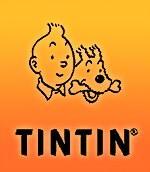



12 comments:
Great post. There's lots I want to comment on, but I'm at work right now and don't have the time.
I'm right there with you on Uncanny X-men, I'm about to break my un-interrupted collection of the book since #150 or somewhere. If you count reprints like X-men Classic and such, then I have the whole X-men story all the way back to Giant Size X-men #1. It makes me sad to break the run, but I'm just not enjoying it anymore.
Wonderful post, Jim.
One thing that my sabbatical from comics did was allow me to come in with a fresh start. While I used to keep buying X-Titles and Claremont out of inertia, I have no run to keep intact anymore. I'm blissfully ignoring anything I don't like, and
Claremont's one of those writers that I'm simply avoiding.
The fact large chunks of this essay revolve around Titans and Claremont X-Men leads me to think we're of the same general age. I had the same feeling: Claremont X-Men was tops .... except for Wolfman/Perez Titans. It's still odd how the franchises diverged. The Titans devolved utterly as the X-Men were ascendant.
I don't know about Jim, but I just turned 28 last Friday.
Hey guys--thanks for the nice replies!
Shane: Happy birthday! Regarding the nearly broken X-Men run--ouch. That's a hard break to make. Maybe we need to start a support group or something. I discovered the Uncanny X-Men back during the Brood saga (issue #163 with Kitty on the cover--god I'm predictable) and read the title sporadically until #201 (Storm vs. Cyclops--I was rooting for Storm; again, predictable as all hell), by which point I'd acquired a pull-list at a local shop for the first time. I hung around for awhile (a few years, in fact) after Claremont left, but the series was just so...bad. I left, and returned when Claremont came back briefly for that disastrous reboot before the current one and (if I recall correctly) before Morrison helmed the franchise. Claremont's X-Men were bad during that quickly aborted reboot, but I bought it anyway, and even got trades of X-Treme X-Men (what can I say, I was feeling weak). All this to say that I'm glad that, although I didn't take a sabbatical from comics like Mark, at least I didn't have an unbroken run of the title or I probably wouldn't be writing about jumping ship right now. A tip of the hat to you for your own breakup with weak storytelling, especially given the momentum of such a long uninterrupted run.
Mark: I'm 33, and yeah, the diverging trajectory of these two title IS weird. I can still remember going to one comic shop downtown, back in about 1981 or '82 and seeing an issue of Uncanny and an issue of NTT side-by-side in these special boxes that the store had put together to advertise the bestsellers of each company. I'm probably going to return to the topic of this pairing at some point, but wow--what a high point those books were for superhero comics. New Teen Titans went downhill for me after Perez left the Baxter series, but not entirely. Despite Wolfman's writer's block and his destruction of the team (wasn't it a self-conscious attempt to make them more like the X-Men? or was he just distracted with writing Crisis?) there were still a few good stories in there and I loved Titans Hunt (even though the book imploded after that).
Johns is taking things in a more or less good direction, but the magic hasn't quite returned for me yet. It could still happen though. I've got a good feeling. (The difference between X-Men and NTT for me is that while I CAN actually conceive of dumping the former, it would be very, very difficult for me to dump the latter, no matter how bad things got--and, good lord, have they tested my patience in the past). The Titans get a free pass from me--but that's the only book that does.
Sigh. This is all making me very nostalgic for those inaccessible boxes of comics in my parents' basement!
G.I. Joe and X-men Classic actually started me on comics. When the new Joe series started I dug out my old comics and read them again. Nostalgia isn't all it's cracked up to be. Most of the time the memories are better than the actual thing.
Yeah, so true. The fact that I don't have access to much of my old fondly-remembered stuff no doubt makes it that much better. Still, I go back and read some of those old 1970s Marvels, Claremont's first Uncanny run or NTT and still think--wow. Powerful stories.
DC's current titles are a nice compromise in the sense that they aim to evoke those memories, while (hopefully) telling a story that feels at the same time completely contemporary and fresh. (Doesn't always work, but it's hitting more than it misses for me right now.)
(Doesn't always work, but it's hitting more than it misses for me right now.)
It is for me as well. Growing up I was a huge Marvel fan, now I'm mainly a DC fan, yet I still buy some Marvel books.
I've mentioned the lure of nostalgia before too, and I have also been an X-fiend in the past, but Chuck Austen drove me from the title. It's kind of sad, but sometimes you have to let go. Although 8 issues in, Milligan on X-Men is actually pretty interesting, in case you're wondering.
I didn't really care for the first arc, but his second is good.
Thanks for the tip about X-Men, Greg. I didn't even know Milligan was on X-Men (!?) and I've really enjoyed his work in the past (esp. Enigma, Shade, and Human Target). I'll check it out. (I sampled Austen's Uncanny run for awhile, but ultimately fled as well.)
Shane--about the drift from Marvel to DC, I wonder how common that experience is and what accounts for it. As you can no doubt tell from the blog, I loved Marvel when I was very young (late 70s) but by the early 80s had become mainly a DC guy (with the exception of the mutants, Avengers, and some Spidey). Bought pretty indisciminately from both (and smaller independent) publishers throughout the 90s, had a brief fling with Crossgen, and now read mainly DC.
My problem with Marvel is their apparent lack of long-term vision. I really, really like serialized storytelling, but in order to really enjoy it, I like to feel that there's some kind of plan that is slowly unfolding (which is why I don't mind being tortured in the short term on a title like Hawkman, where the main character is apparently "killed," for instance). DC definitely makes some missteps, but in recent years, their long-term vision has been inspired. Marvel, meanwhile, seems to be making it up as they go along. House of M (which I hate myself for buying) is the most glaring recent example of why I have little confidence in Marvel as a publisher. Sure, they have a couple of stellar books, but I'm much less likely to take a chance on one of their titles if I have and extra $5 in my pocket.
I really have little to comment on (A LIE: I have plenty of which to comment, both in terms of "spot on!" and "I'd have to say I disagree with you there, and here's why..."; I'm just too tired at the moment). I just wanted to say that I now have an addiction to your blog - the intellectual analysis, exquisite writing, and consistently fair and open minded tone that I find on your page are fantastic and extraordinarily rare within comics criticism.
So pretty much all hosannahs. And maybe I'll say "huzzah!" too. "Huzzah!"'s have fallen out of fashion and that really is an incredible shame.
Thanks for reading, Richard! And thanks also for the kind words (especially hazzah!). I hope you'll stop back in and let me know what you think about this, that, or the other thing...once you've gotten some rest!
Post a Comment